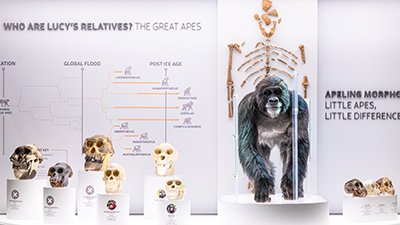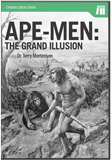
Meat-Butchering Tools for "Lucy"
Did the friends and family of supposed ape-woman “Lucy” use tools to butcher meat for meals?
News Source
- The New York Times: “Lucy’s Kin Carved Up a Meaty Meal, Scientists Say”
The media headlines leave little room for doubt: members of the species Australopithecus afarensis used tools, showing another link between what evolutionists consider proto-humans (but what most creationists consider apes) and us. But dig a little deeper, and the story begins to unravel.
The team’s analysis, they argue, shows that only tools could have made the cut marks.
In January 2009, researchers working in Ethiopia turned up four bones that showed signs of having been cut. Intrigued, the scientists dated the age of the rocks in which the bones were found at between an alleged 3.2 to more than 4 million years old. And although no tools were found nearby, the scientists raced to a conclusion: the cut marks were made by tools, and the tools were wielded by the most advanced beings thought to have been living at the time: A. afarensis, like Lucy.
Although the find dates back nearly a million years (or more) earlier than what evolutionists previously believed about tool use, the team’s analysis, they argue, shows that only tools could have made the cut marks.
The conclusion seems like a stretch, considering neither A. afarensis nor any tools were found at the location, and considering A. afarensis were not thought to have eaten meat. But as the Times reports, “A. afarensis is thought to be the only species living in this region at the time,” hence the team’s conclusion.
Other scientists are unconvinced, however. University of California–Berkeley paleoanthropologist Tim D. White said the team’s conclusions “greatly outstrip the evidence,” adding, “We have been working sites in this area for 40 years, and not a single stone tool has been found in deposits of this antiquity.”
But adopting the young-earth creation model would, unsurprisingly, resolve the dilemma between ascribing tool use to a phantom carnivore or to an ancient ape-man. If humans were created in the same week as all life—highly intelligent humans with the capacity for using tools—then it’s perfectly reasonable to find bones showing tool marks that humans could have made. And if buried in sediments dated at supposedly three or four million years old, the bones are almost certainly from the post-Flood period; perhaps they were discarded in a stream or river that eventually buried them in sediment.
Further Reading
- Did Humans Really Evolve from Apelike Creatures?
- The Origin of Humans
- Get Answers: Ape-Man, Missing Links, Fossils
For More Information: Get Answers
Remember, if you see a news story that might merit some attention, let us know about it! (Note: if the story originates from the Associated Press, FOX News, MSNBC, the New York Times, or another major national media outlet, we will most likely have already heard about it.) And thanks to all of our readers who have submitted great news tips to us. If you didn’t catch all the latest News to Know, why not take a look to see what you’ve missed?
(Please note that links will take you directly to the source. Answers in Genesis is not responsible for content on the websites to which we refer. For more information, please see our Privacy Policy.)
Recommended Resources

Answers in Genesis is an apologetics ministry, dedicated to helping Christians defend their faith and proclaim the good news of Jesus Christ.
- Customer Service 800.778.3390
- © 2024 Answers in Genesis






